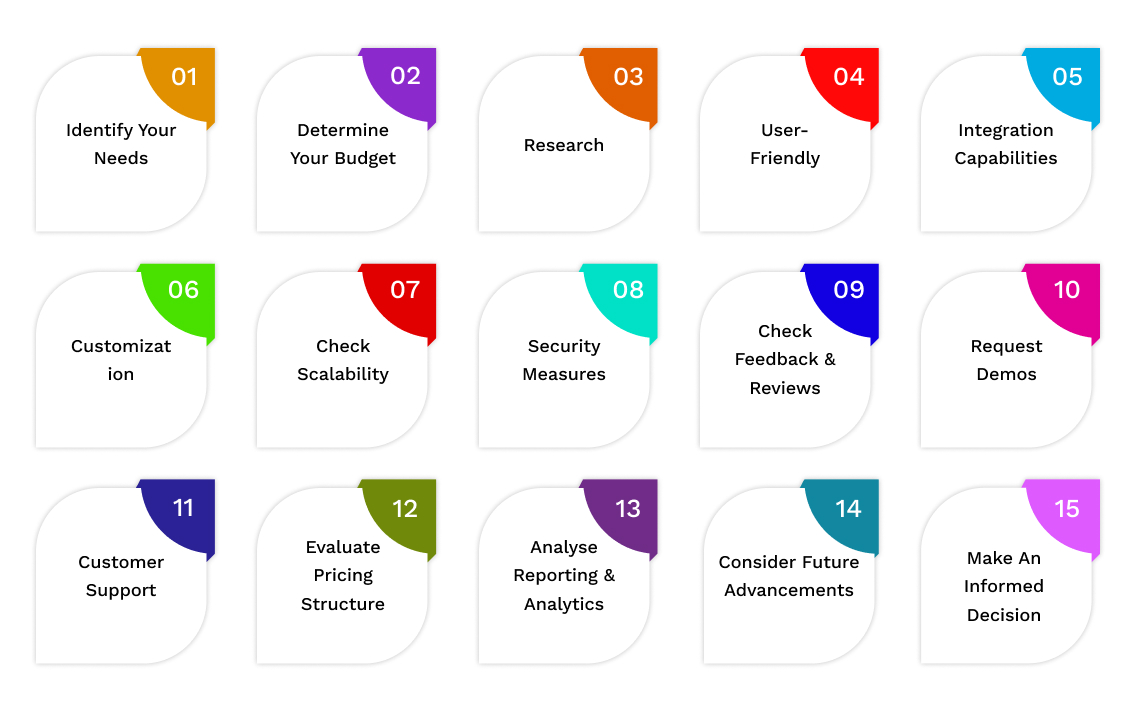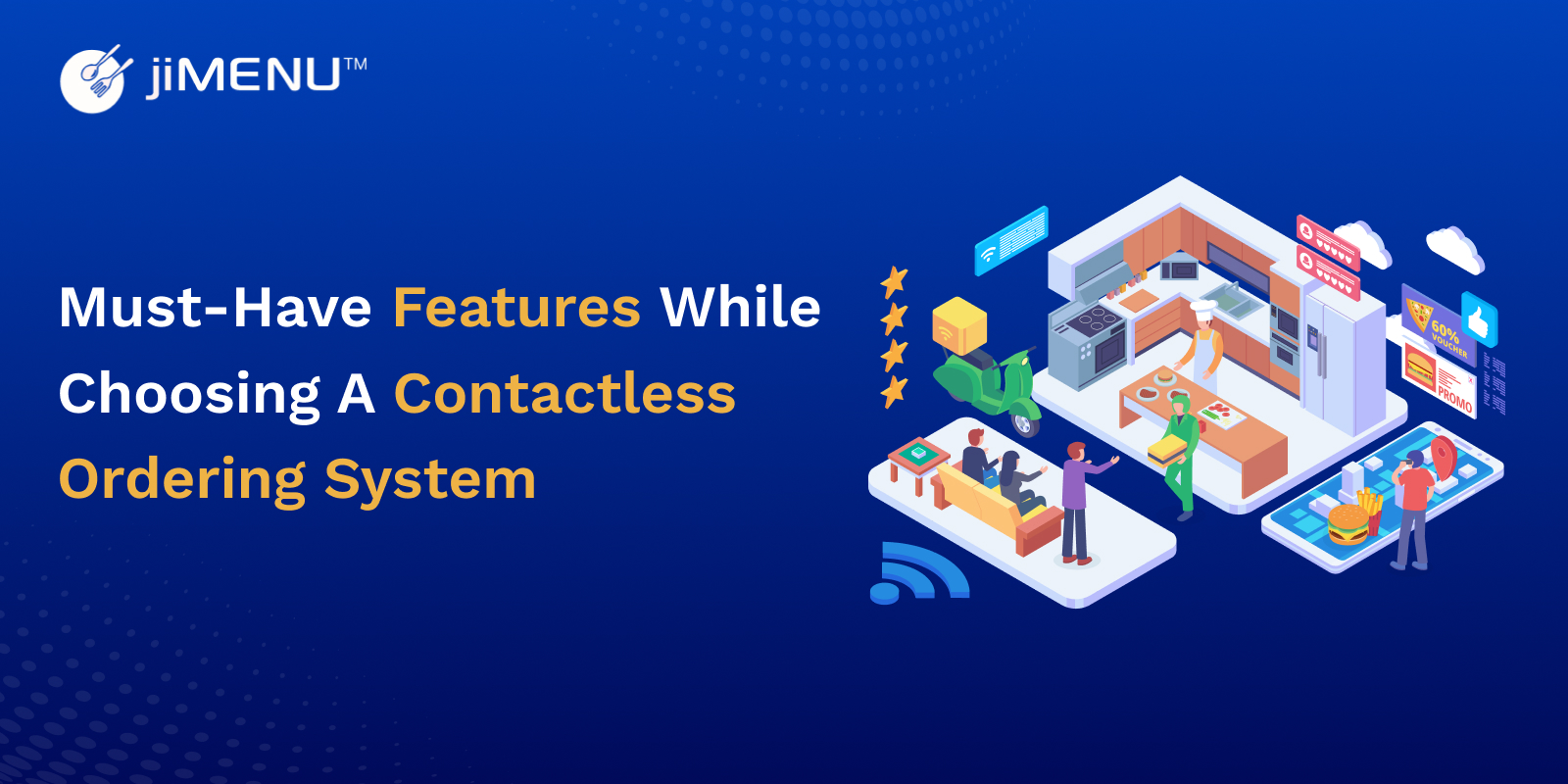In recent years, the restaurant industry has witnessed a significant shift toward contactless ordering systems. With the advancement of technology and the increasing demand for convenience, many restaurants are adopting these systems to enhance their operations and provide a seamless dining experience for their customers. However, there are numerous options on the market. So, it can be overwhelming for restaurant owners to choose the right contactless ordering system that suits their needs.
A Few Factors To Consider While Choosing Contactless Ordering System
Choosing the right contactless ordering system for a restaurant requires careful consideration of various factors. The system should prioritize ease of use and provide a seamless user experience for both customers and staff. Here are a few factors that restaurants must consider before choosing a contactless ordering system:

Ease of Use and User Experience: One of the most crucial factors to consider when choosing a contactless ordering system is its ease of use and user experience. The system should be intuitive and user-friendly to use. Moreover, the system should offer a seamless and efficient ordering process, allowing customers to browse menus, customize their orders, and make payments effortlessly.
Integration with Existing Systems: Another important factor to consider is how well the contactless ordering system integrates with the existing systems in the restaurant. The system you chose must be able to integrate with the restaurant's POS system, kitchen management software, inventory management software, and other relevant systems. The integration ensures that orders placed through the contactless system are automatically synced with other operational processes, minimizing manual errors and streamlining overall operations. Hence, it is crucial to choose a system that offers robust integration capabilities to avoid any disruptions or inefficiencies in daily operations.
Customization and Flexibility: Every restaurant has its own unique requirements and preferences when it comes to menu offerings, pricing structures, promotions, and discounts. Therefore, it is essential to choose a contactless ordering system that offers customization and flexible options. The system should allow restaurants to easily update menus, add or remove items, set pricing rules, and apply discounts or promotions as needed. Additionally, the system must be adaptable to different types of restaurants, whether it's a fast-food chain, a fine dining establishment, or a food truck. Customization and flexibility are crucial to ensuring that the contactless ordering system aligns with the restaurant's brand and operational needs.
Payment Options and Security: A reliable contactless ordering system should offer a variety of payment options to cater to different customer preferences. It should support payment methods such as credit or debit cards, mobile wallets, and online payment platforms. Moreover, the system should prioritize security measures to protect customer data and financial information.
Analytics and Reporting: An effective contactless ordering system should provide comprehensive analytics and reporting capabilities. It should generate real-time data on order volumes, popular menu items, peak hours, customer preferences, and other relevant metrics. This data can help restaurant owners make informed decisions regarding menu optimization, staffing requirements, marketing strategies, and overall business performance.
Scalability and Support: When choosing a contactless ordering system for a restaurant, it is crucial to consider its scalability potential. The system should be able to accommodate the restaurant's growth and expansion plans without significant disruptions or additional costs. Additionally, reliable technical support from the system provider is essential to address any issues or concerns promptly. A responsive support team can ensure smooth operations and minimize downtime in the event of any technical glitches or system updates.
Cost and Return on Investment: Cost is crucial to consider for any business decision. It is essential to evaluate the pricing structure of different systems and compare them based on the features and benefits they offer. Invest in a system that offers advanced features and robust support.
Advantages of Choosing a Contactless Ordering System For Restaurants
With the significant shift in the food industry towards digitalization and automation, businesses are seeing many advancements. One of the most notable advancements is the evolution of contactless ordering systems. These systems allow customers to place orders and make payments without physical contact with menus, cashiers, or card machines.

Enhanced Safety and Hygiene Measures: The pandemic has highlighted the importance of maintaining strict safety and hygiene measures in public spaces, including restaurants. Contactless ordering systems provide an effective solution to minimize physical contact between customers and staff, reducing the risk of virus transmission. By eliminating the need for physical menus and cash transactions, these systems help create a safer dining environment for customers and employees. Additionally, contactless ordering systems can contribute to improved overall hygiene in restaurants. With contactless ordering, customers can access digital menus on their devices, eliminating the need for physical menus that require constant cleaning and sanitization.
Streamlined Operations and Increased Efficiency: Implementing a contactless ordering system can streamline restaurant operations and enhance overall efficiency. Restaurants can eliminate the need for manual order-taking processes by allowing customers to place their orders directly through a mobile app or website. It reduces the chances of errors or miscommunication between staff members and customers. Moreover, contactless ordering systems often integrate with restaurant management software, enabling seamless communication between front-of-house and back-of-house operations. Orders placed through these systems can be automatically transmitted to the kitchen, minimizing delays and ensuring the timely preparation of meals. This streamlined process improves efficiency and enhances customer satisfaction by reducing waiting times.
Improved Customer Experience: Contactless ordering systems offer several features that can help food businesses enhance their customer experience. Firstly, these systems provide customers with the convenience of browsing menus and placing orders at their own pace.
Contactless ordering systems often include customization options, allowing customers to personalize their orders according to their preferences. This level of flexibility can lead to increased customer satisfaction and loyalty. Furthermore, these systems facilitate faster payment processes. By integrating with digital payment platforms, customers can settle their bills seamlessly through their mobile devices. Improved customer experience eliminates the need for physical cash or card transactions, reducing waiting times, and enhancing convenience for customers and staff.
Upselling Opportunities and Increased Revenue: Contactless ordering systems provide restaurants with new opportunities for upselling and increasing revenue. Through digital menus, restaurants can showcase high-margin items, daily specials, or limited-time offers more effectively. Restaurants can capture their attention and encourage them to explore additional menu items by highlighting these options on the customer's device screen. Moreover, contactless ordering systems include features such as recommendations or pairing suggestions based on customer preferences.
Data Collection and Analysis: Another advantage of contactless ordering systems is the ability to collect valuable data regarding customer preferences and behavior. By tracking customer orders and interactions with the system, restaurants can gain insights into popular menu items, peak hours, average order values, and other metrics. This data can be used to inform strategic decision-making processes such as menu optimization, pricing adjustments, or targeted marketing campaigns.
Cost Reduction: Implementing contactless ordering systems can also lead to reduced staffing costs for restaurants. By automating the order-taking process, restaurants can allocate their staff resources more efficiently. Instead of spending time taking orders manually, staff members can focus on other critical tasks such as food preparation, customer service, or maintaining cleanliness.
How To Choose a Contactless Ordering System
Choosing a contactless ordering system for restaurants requires careful consideration of various factors. These factors ensure that it meets the specific needs and requirements of the establishment. Here are the things to take care of while selecting a contactless ordering system.

Identify Your Needs: Before diving into the selection process, it is crucial to understand the unique requirements of your restaurant. Consider factors such as the size of your establishment, the volume of orders you typically handle, the types of cuisine you offer, and any specific features or functionalities you may require.
Determine Your Budget: Contactless ordering systems can vary significantly in terms of cost. It is crucial to have a budget range that aligns with your restaurant's financial capabilities. Consider upfront costs, such as hardware and software expenses and ongoing fees or subscription charges.
Research: Conduct research to identify the different contactless ordering systems available in the market. Look for systems that have been specifically designed for restaurants and offer features like menu customization, order management, payment integration, and customer analytics.
User-friendly: The chosen contactless ordering system should be intuitive and easy to use for both customers and staff members. Look for systems with a user-friendly interface that allows customers to browse menus, place orders, and make payments seamlessly. Similarly, ensure that the system provides a straightforward order management interface for staff members.
Integration capabilities: If your restaurant already uses other software solutions like POS (Point of Sale) systems or inventory management tools, it is crucial to consider the integration capabilities of the contactless ordering system. Seamless integration can streamline operations and prevent data discrepancies.
Customization: Every restaurant has its own unique branding and menu offerings. Look for a contactless ordering system that allows you to customize the interface to reflect your brand identity accurately. Additionally, ensure that the system can accommodate any specific menu configurations or modifications you may require.
Check Scalability: As your restaurant grows, it is crucial to choose a contactless ordering system that can scale your business. Consider whether the system can handle increased order volumes, support multiple locations if applicable, and accommodate future expansion plans.
Security Measures: Given the sensitive nature of customer data and payment information, it is crucial to prioritize security when selecting a contactless ordering system. Look for systems that offer robust encryption protocols, secure payment gateways, and compliance with industry standards.
Check Feedback and Reviews: Before making a final decision, take feedback from other restaurant owners or industry professionals who have experience with contactless ordering systems. Online reviews can provide valuable insights into the pros and cons of different systems.
Request Demos: Once you have shortlisted a few contactless ordering systems that meet your requirements, reach out to the respective vendors and request demos or trials. This hands-on experience will allow you to assess the system's performance, ease of use, and overall suitability for your restaurant.
Customer Support: A reliable customer support system is crucial when implementing a new technology solution. Ensure that the contactless ordering system vendor offers responsive customer support channels such as phone, email, or live chat. Additionally, inquire about training resources or documentation provided to assist with onboarding and troubleshooting.
Evaluate Pricing Structure: Carefully review the pricing structure of each contactless ordering system under consideration. Some vendors may charge a flat fee, while others may have a tiered pricing model based on factors like order volume or additional features. Choose a pricing structure that aligns with your restaurant's financial goals and growth projections.
Analyze Reporting and Analytics: The ability to gather data and gain insights into customer behavior and preferences is a valuable feature of contactless ordering systems. Evaluate the reporting and analytics capabilities of each system to ensure that it provides the necessary data to make informed business decisions.
Consider Future Advancements: Technology is constantly evolving, and new features and functionalities are regularly introduced in contactless ordering systems. Consider whether the system you choose has a track record of innovation and whether it can adapt to future advancements in the industry.
Make an Informed Decision: After considering all the above factors, evaluate the pros and cons of each contactless ordering system and make an informed decision based on your restaurant's specific needs, budget, and growth plans.
Conclusion:
In conclusion, contactless ordering systems offer numerous advantages for restaurants in terms of safety, efficiency, customer experience, and revenue generation. As the restaurant industry continues to evolve and adapt to changing consumer preferences and technological advancements, implementing contactless ordering systems has become a crucial step toward ensuring success and sustainability.
Choosing a contactless ordering system for restaurants can help you generate revenue and gain loyal customers. So, if you are looking the services that provide a robust and secure contactless ordering system, choose jiMenu.
jiMenu has numerous restaurants to enhance sales by offering its robust and customized services. Request a demo.












